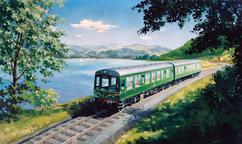

Lithograph, coloured, Great Western Railway, Bristol Station, sketched and drawn in stone, by J C Bourne, printed by C F Cheffins, 1840, depicting interior of station with trains, workers and passengers.
Bristol Station opened in 1840 as the western terminus of the Great Western Railway from London Paddington. The station was designed by Isambard Kingdom Brunel and is now known as Bristol Temple Meads Station. It is Bristol’s oldest and largest station. The station was extended in 1870 and again in 1930 to meet rising demand. This lithograph by John Cooke Bourne (1814–1896) shows the interior of the station, with platforms on the far left and right. The platforms are far apart because the station has two broad gauge carriage sidings between the platform lines. The station building was extended in 1870 and again in 1930 to meet rising demand. The original platforms depicted here were closed in 1965 as part of further modernisation work. After this the original station building was used as a car park. In 2020 Bristol City Council sold the original building to Network Rail.
This lithograph was published in 1846 as part of a series of views of the Great Western Railway by Bourne. Eight years earlier Bourne produced a series of views showing the construction of the London & Birmingham Railway (also in the National Railway Museum collection). The Great Western views were very different to these earlier views: by 1846 the Great Western was already well established, so Bourne produced a series of drawings that reflected the grandeur and permanence of Brunel’s great broad-gauge railway.
Bourne was commissioned to create the Great Western series by Charles Frederick Cheffins. Cheffins was an engineer and draughtsman known for his drawings of locomotive engines, his cartographic work, and as a surveyor for numerous railroad projects. He started making lithographs in 1830 and often lithographed work for other artists. However, Bourne had the ability to transfer his own drawings onto the lithographic stone, so in this case Cheffins served solely as the printer.
It has been estimated that no fewer than 2,000 prints of railway subjects were produced during the years 1830 to the late 1840s, and scarcely a line opened without at least one view of its engineering accomplishments being published. It is difficult for us today to understand the emotional as well as financial commitment to railways during these early years. The railway was often seen as a slowly spreading symbol of change and progress towards a better world.
Details
- Category:
- Pictorial Collection (Railway)
- Object Number:
- 2001-8622
- Measurements:
-
: 15.5512 x 21.9685 in.; 395 x 558 mm
- type:
- print and lithograph
- credit:
- British Rail, Clapham




